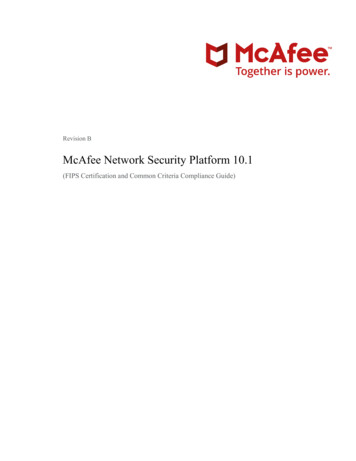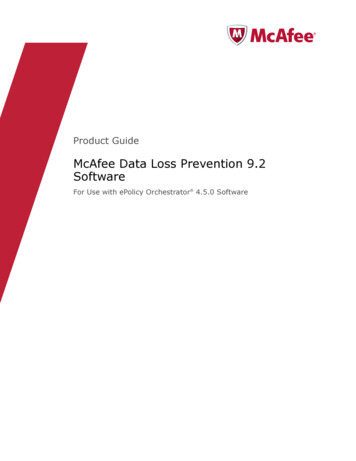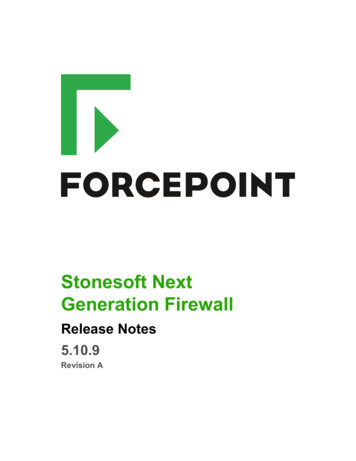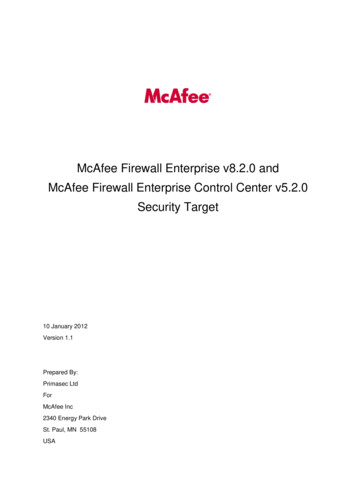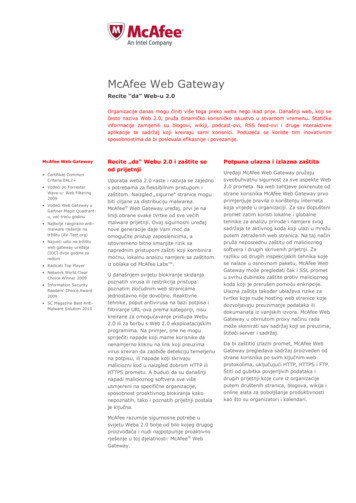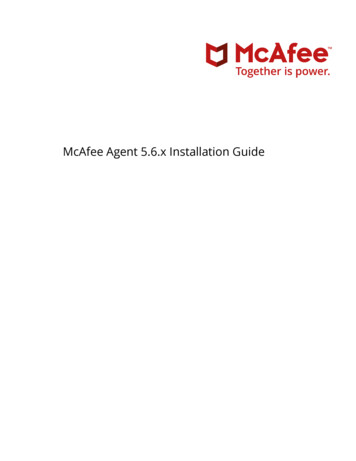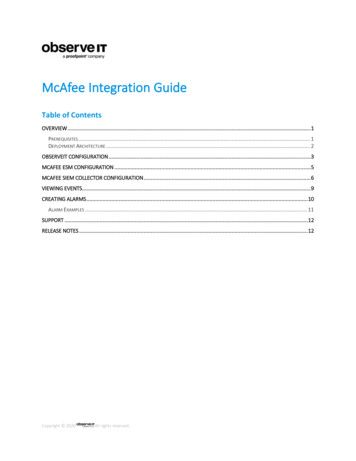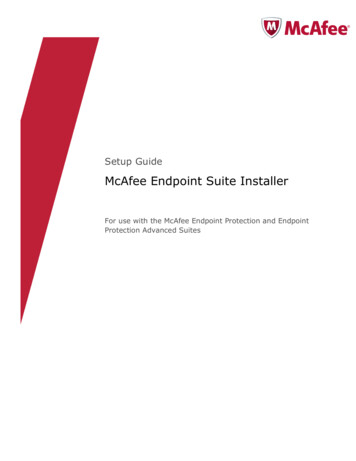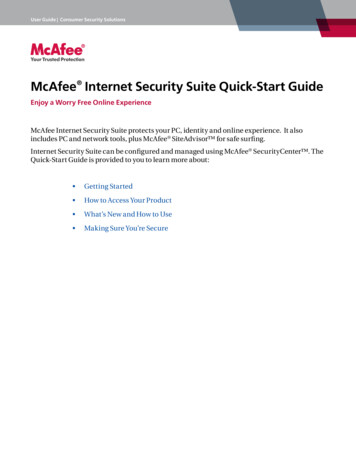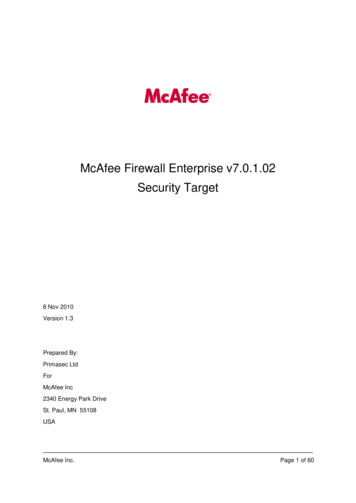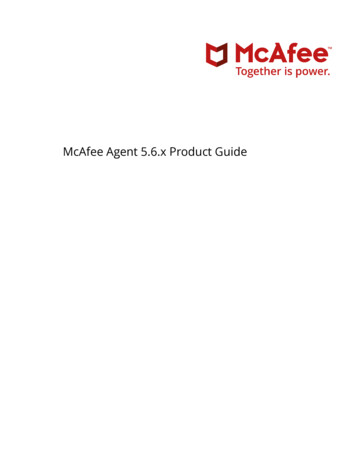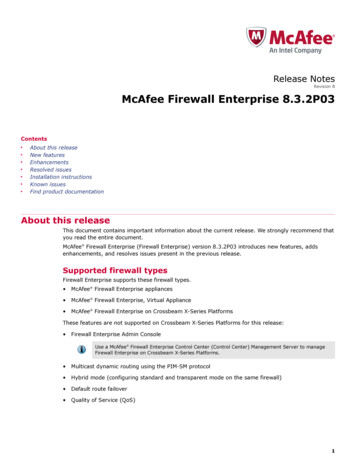
Transcription
McAfee Product Security PracticesMcAfee Product SecurityPractices14 March 2022McAfee PublicPage 1 of 1214 March 2022Expires 1 July 2022
McAfee Product Security PracticesTable of ContentsImportance of Security . 3Software Development Lifecycle (SDLC) at McAfee . 3Development Methodologies. 4Security Development Lifecycle (SDL) . 4SDL.O2 High-Level SDL . 5SDL.T2.1 Security Architecture Review. 6SDL.T2.2 Security Design Review . 6SDL.T3 Threat Modeling . 6SDL.T4 Privacy and Data Protection Review . 6SDL.O7 Security Training . 7SDL.O4 Software Security Architects . 7SDL.T6 “Trust and Verify” . 7SDL.O5 Complimentary Security Testing . 8SDL.O6 McAfee Policies . 8SDL.O5 Software Security Tools . 9SDL.O9.1 Product Security Maturity Model . 9SDL.O3 Vulnerability Response . 10Disclaimer . 10Points of Contact . 10Glossary. 10Revision History. 12McAfee PublicPage 2 of 1214 March 2022Expires 1 July 2022
McAfee Product Security PracticesImportance of SecurityAt McAfee, LLC we take product security very seriously. Our practices include designing for both securityand privacy, in product software, IT applications, and cloud services. We have rigorous software securitypolicies and processes designed to proactively find and remove software security defects such as securityvulnerabilities. We understand that our products, IT applications, and cloud services must not only fulfillthe stated function to help protect our customers, the McAfee software itself must also aim to protect itselffrom vulnerabilities and attackers. McAfee strives to build software that demonstrates resilience againstattacks.We also understand that our customers may, from time to time, wish to review our software securitypractices so that they may make their own risk-based decisions on how best to use our products and tofulfill any due diligence responsibilities they may have.Specific policies and practices can vary by product. The summary of practices described in this statementapplies to all McAfee branded products as well as customer facing IT and Web applications.Software Development Lifecycle (SDLC) at McAfeeAll of McAfee’s software is developed using the Agile or Continuous Integration / Continuous Delivery(CI/CD) methodology. These agile and CI/CD practices are referred to as the Agile SoftwareDevelopment Lifecycle (SDLC). The Waterfall methodology is no longer used within McAfee. At McAfee,the SDLC is referred to internally as the Product Lifecycle Framework (PLF) v2.McAfee PublicPage 3 of 1214 March 2022Expires 1 July 2022
McAfee Product Security PracticesDevelopment MethodologiesThe chart below was developed for a traditional Waterfall SDLC. This chart has been adapted andredefined for McAfee’s Agile SDL, which includes CI/CD. Security and privacy tasks are integrated intoMcAfee’s SDL as a seamless, holistic process designed to produce software that has appropriate securityand privacy built into it.While the following description may appear to apply only to Waterfall development, the same set ofsecurity tasks are performed across the iterations of Agile just as they are performed in discrete phasesduring Waterfall. For CI/CD, SDL activities are determined by certain triggers which are set by milestones,events, and time intervals. McAfee encourages full engagement by software security architects andengineers within Agile sprints to ensure that security and privacy are integral parts of the Agile process.Security Development Lifecycle (SDL)In line with IT and application development industry standards such as ISO/IEC 27001, 27002, and 27034,BSIMM, and SAFECode, McAfee software development has processes designed to adhere to a SecurityDevelopment Lifecycle (SDL).McAfee’s SDL covers the technical, operational, and enterprise aspects of building secure software. TheSDL technical activities defined for each product, IT application, or cloud services release is the focus ofthis document.McAfee PublicPage 4 of 1214 March 2022Expires 1 July 2022
McAfee Product Security PracticesTechnical SDL Activities (Engineering) SDL.T1Security Definition of Done (DoD) SDL.T2Security Architecture & Design Reviews SDL.T3Threat Modeling SDL.T4Privacy & Data Protection Review SDL.T5Secure Coding Standards SDL.T6Manual Code Review SDL.T7Open Source & 3rd Party Libraries SDL.T8Vendor Management SDL.T9Static Security Testing (SAST) SDL.T10 Interactive Security Testing (IAST) SDL.T11 Dynamic Security Testing (DAST) SDL.T12 Fuzz Testing SDL.T13 Vulnerability Scan SDL.T14 Penetration Testing SDL.T15 Security Testing & Validation SDL.T16 Operating Environment(security To Do list before shipping)(includes cryptography)(includes software legal compliance)(includes Web Application scanning)(includes public cloud services)Not all of the 16 technical SDL activities are mandatory for each product release. Some are conditionallyrequired. The SDL.T1 Security Definition of Done (DoD) lists which activities are required for each releaseand is owned by the SSAs. Several activities are mandatory no matter what, such as the Security DoD(T1), Privacy Review (T4), Manual Code Review (T6), and SAST (T9).Operational SDL Activities (InfoSec) SDL.O1 Program SDL.O2 Security Development Lifecycle (SDL) SDL.O3 Vulnerability Response (PSIRT/ASIRT) SDL.O4 People & Resources SDL.O5 Tools & Services SDL.O6 Policy & Compliance SDL.O7 Security Training SDL.O8 Metrics & Reporting SDL.O9 Maturity ModelsEnterprise SDL Activities (IT) SDL.E1 Vulnerability Management SDL.E2 Risk Management SDL.E3 Asset Management SDL.E4 Remediation Management SDL.E5 Exception Management SDL.E6 Security Monitoring SDL.E7 CertificationsThe following paragraphs describe, at a high level, the McAfee SDL process.SDL.O2 High-Level SDLFor a new product, the security process typically begins at project initiation. A seasoned security architector McAfee Software Security Architect (SSA) or Engineer (SSE) assesses a proposal for its securityimplications. The output of this engagement is any additional security features that will be added tosoftware self-protection so that the software can be deployed by the different security postures ofMcAfee’s customers.McAfee PublicPage 5 of 1214 March 2022Expires 1 July 2022
McAfee Product Security PracticesSDL.T2.1 Security Architecture ReviewAny project that involves a change to the architecture of the product is required to go through a securityarchitecture and design review. The proposed architectural and design changes are analyzed for securityrequirements, as well as analyzed within the whole of the architecture of the software for each change’ssecurity implications. An architecture review may be a discrete event, may be accomplished iteratively asthe architecture progresses (Agile), or may be updated continuously (CI/CD).SDL.T2.2 Security Design ReviewThe SDL requires that designs that contain security features or effects are reviewed to make sure thatsecurity requirements are built correctly. The SSA signs off when the design meets expectations. Allfunctional items, including security design elements, are included in the thorough functional test plan. Likearchitectural reviews, a design review may be a discrete event or may be accomplished iteratively whendesign work occurs (Agile or CI/CD).SDL.T3 Threat ModelingA threat model is created or updated. The output of this analysis will typically be the security requirementsthat must be folded into the design that will be implemented.SDL.T4 Privacy and Data Protection ReviewIn tandem with architecture and design reviews, privacy and data protection reviews are conducted. APrivacy Impact Assessment (PIA) is performed to determine if any additional privacy activities are requiredto protect personal data. Privacy reviews cover the whole lifecycle of personal data and often extendbeyond the product collecting the data and include backend systems and infrastructure.McAfee PublicPage 6 of 1214 March 2022Expires 1 July 2022
McAfee Product Security PracticesSDL.O7 Security TrainingAt McAfee, we foster industry standard secure coding practices. To that end, McAfee University and ourMcAfee Learning Management System (LMS) contains many courses on building software securely.Some are home-grown from internal subject matter experts, while others are purchased from third-partyvendors. Developers are expected to pursue ongoing developer education. Self-training is encouraged.SDL.O4 Software Security ArchitectsSoftware Security Architects (SSA) and Software Security Engineers (SSE) are assigned to each productline and IT application. Our 120 SSAs and SSEs perform the SDL activities and help to confirm thatevery part of the software security process is applied appropriately.Software Security Architect/Engineer Qualifications1. A minimum of 3-5 years software development experience2. A passion for or background in software security3. Approved by the BU Engineering VP/Sr. Director & SSA BU Lead4. Dedicate a minimum of 20% of their time doing software security tasks5. Time to be trained in software security, reviews, tools, and processes6. Be collocated within each engineering team / BU7. Must not only know how to develop (build) software but also know how to deconstruct it (take itapart) while “thinking like a hacker”SDL.T6 “Trust and Verify”Alongside each developer’s responsibility to produce secure code, McAfee has a “trust and verify” attitude.All new code must go through a manual code review. For non-sensitive and noncritical functions, thiscode may solely go through peer review. Critical and sensitive changes are also reviewed by staff with asufficient level of expertise to assess critical changes.McAfee PublicPage 7 of 1214 March 2022Expires 1 July 2022
McAfee Product Security PracticesMaking use of overlapping complementary approaches, we employ several tools and automation to findsecurity defects that may slip through manual code review. All code must be statically analyzed (unlessno static analyzer exists for the language or environment). All web code is expected to undergo a webvulnerability scan. Other forms of input are routinely fuzz tested. Medium, high, and critical severityissues must be fixed before release. Low severity issues are prioritized then usually fixed or mitigated infuture patches and product releases.SDL.O5 Complimentary Security TestingCritical customer-premise releases may additionally be put through a third-party penetration analysis on acase-by-case basis before release. All hosted systems are routinely vulnerability scanned and penetrationtested by either our Information Security (InfoSec) department or by a third-party engagement.We believe that the preceding is a solid plan in line with industry standards and best practices. Since nocomputer system can be absolutely secure, McAfee does not claim that the SDL will prevent any particularissue or any collection of issues. McAfee reevaluates and updates its SDL policies and process on aregular basis.SDL.O6 McAfee PoliciesMcAfee believes that customer relations are best served through open, transparent dialog. We encouragecustomer engagement, including requests about our software security process.There are some limitations as to what we may share. For instance, we never share our source codeoutside of McAfee’s direct control. Also, we never make available the list of vulnerabilities that are foundas a result of our own internal investigations or from any of our automated testing tools. After internallydiscovered vulnerabilities have been addressed in a hotfix, patch or new product release, all medium andhigh severity issues are documented in product release notes and in security advisories.It is important to note that any scan of McAfee's production systems will be considered an attack.Response to perceived attack will be rapid and decisive. Please coordinate your needs with your accountmanager. Availability of test systems is subject to customer need, customer cost, and timing.McAfee PublicPage 8 of 1214 March 2022Expires 1 July 2022
McAfee Product Security PracticesSDL.O5 Software Security ToolsMcAfee engineering teams apply an appropriate combination of tools depending upon the targetprogramming language, architecture, and the execution run-time. These tools are a combination ofinternally developed, vendor purchased, and open source tools. We may provide a list of utilized toolsupon request. For reference, we use many of the security tools listed in OWASP’s Security Testing Toolslist.SDL.O9.1 Product Security Maturity ModelThe SDL describes the “what” of software security. McAfee’s Product Security Maturity Model describesthe “how well” of software security.For each SDL activity, the PSMM describes 5 different levels from 0-4. These levels are: Level 0None Level 1Minimal[Initial] Level 2Good[Basic] Level 3Better[Acceptable] Level 4Best[Mature]With 16 technical activities and 9 operational activities, a perfect score is 100. McAfee softwaredevelopment teams assess their products annually using the PSMM. This allows us to focus our effortson what each particular product needs the most, while measuring the overall maturity of each product line,engineering BU, and the company as a whole.McAfee PublicPage 9 of 1214 March 2022Expires 1 July 2022
McAfee Product Security PracticesSDL.O3 Vulnerability ResponseTo handle vulnerabilities discovered in shipping McAfee products and live customer-facing applications,McAfee has a Vulnerability Response Team. This team consists of both PSIRT and ASIRT. The ProductSecurity Incident Response Team (PSIRT) responds to product vulnerabilities in shipping products. Theywork with the discoverer and engineering to develop and deliver a patch and accompanying securitybulletin. The vulnerability’s severity (CVSS base-score) and business risk factors determine our fixresponse time (SLA). Similar to PSIRT, the Application Security Incident Response Team (ASIRT)responds to IT application and cloud services vulnerabilities in both externally and internally facing ITapplications.DisclaimerNo computer system can be absolutely secure. McAfee makes no warranty concerning any malfunctionsor other errors in its hardware products or software products caused by viruses, infections, worms, orsimilar malicious code not developed or introduced by McAfee. McAfee makes no warranty that anyhardware products or software products will protect against all possible security threats, includingintentional misconduct by third parties. McAfee is not liable for any downtime or service interruption, forany lost or stolen data or systems, or for any other damages arising out of or relating to any such actionsor intrusions.Points of Contact Meredith Stickle, Director – Information Security, McAfee LLCGlossarySDLSecurity Development LifecycleA secure software development methodology that condenses the traditional waterfall methodologydelivery cycles into weeks instead of month. Used by all McAfee software development teams.ASIRTApplication Security Incident Response TeamPart of the Vulnerability Response team within McAfee that responds to IT application and cloudservices vulnerabilities in both externally and internally facing IT applications.CI/CDContinuous Integration / Continuous DeliveryA time frame for releasing software updates more frequently than agile as more products becomecloud-native.DASTDynamic Analysis Security TestingRun-time code review using automated tools.GDPRGeneral Data Protection RegulationThe EU’s privacy regulation effective 25 May 2018.IASTInteractive Analysis Security TestingIAST is a form of application security testing that stems from a combination of dynamic applicationsecurity testing (DAST) and runtime application self-protection (RASP) technologies.PIAPrivacy Impact AssessmentA privacy review conducted on all products to determine if additional privacy activities are requiredbefore a product is released.McAfee PublicPage 10 of 1214 March 2022Expires 1 July 2022
McAfee Product Security PracticesPLFProduct Lifecycle FrameworkMcAfee’s SDLC.PSIPotentially Shippable IncrementAn agile term that means that each unit produced from a series of Sprints has a quality of completion.A governance checkpoint determines each release. PSCs participate in release decisions. There is nomandate to release a PSI.PSIRTProduct Security Incident Response TeamPart of the Vulnerability Response team within McAfee that responds to product vulnerabilities inshipping products. urity-bulletins.aspx.PSMMProduct Security Maturity ModelMeasures how well each SDL activity is being performed.SASTStatic Analysis Security TestingSource code review using automated tools.SDLSecurity Development LifecycleThe security aspects of an SDLC.SDLCSoftware Development LifecycleDescribes the processes, activities, and deliverables for developing, testing and shipping software.SSASoftware Security ArchitectA senior security architect within McAfee responsible for all security-related activities for a givenproduct line.SSESoftware Security EngineerA security engineer within McAfee responsible for all security-related activities for a given product line.SSEs are typically not as experienced as SSAs.McAfee PublicPage 11 of 1214 March 2022Expires 1 July 2022
McAfee Product Security PracticesRevision HistoryRevision HistoryNameVersion Change DescriptionBrook SchoenfieldBrook SchoenfieldBrook SchoenfieldBrook SchoenfieldHarold ToomeyHarold ToomeyHarold ToomeyHarold ToomeyHarold Toomey123459101415Harold Toomey16Harold ToomeyHarold Toomey1718Harold Toomey19Harold Toomey20Harold ToomeyMatt ValdesMatt ValdesMatt ValdesMatt ValdesMatt ValdesMatt ValdesMatt ValdesMatt Valdes212223242526272829DateInitial DraftMinor content updates.Minor content updates.Six-month review. Reformatted document.Six-month review. Rebranded from McAfee Inc. to Intel Security.Add Points of ContactUpdated Software Security Tool List.Annual review. Added Glossary.Six-month review. Updated Agile SDL Activities list.Six-month review. Rebranded from Intel Security to McAfee, LLC.Removed Software from the title.Minor updates.Six-month review. Removed terms from the glossary.Six-month review. Renamed PSCs to SSAs. Added Revision Historytable for FedRAMP. Renamed title from Product to Software to includeIT Application security. Added all SDL Activities.Added Application and Enterprise SDL activities. Removed JamesRansome who left McAfee in June 2018.Renamed Agile SDL to McAfee SDL. Updated SDL activities list.Updated points of contactSix-month review. Minor content updatesMinor content update.Bi-annual content reviewRenew expired links. Minor content update.Bi-annual content reviewBi-annual content reviewUpdate resource links and contact information.7 Aug 201428 Aug 201428 Aug 20149 Dec 20146 Apr 201518 May 201522 May 20152 Feb 201625 July 201628 Mar 201728 Apr 201712 Oct 20172 Apr 20185 July 20181 Nov 20181 June 201918 Feb 202002 Mar 202029 June 20206 August 20202 Feb 20211 July 202114 March 2022McAfee and McAfee logo are registered trademarks of the McAfee, LLC in the US and/or other countries. The M Shield logo is aregistered trademark of McAfee, LLC. in the US and/or other countries. Other marks and brands may be claimed as the property ofothers. Copyright 2022 McAfee, LLC, 2821 Mission College Blvd., Santa Clara, CA 95054, 1.888.847.8766, www.McAfee.com.McAfee PublicPage 12 of 1214 March 2022Expires 1 July 2022
SDL.E3 Asset Management SDL.E4 Remediation Management SDL.E5 Exception Management SDL.E6 Security Monitoring SDL.E7 Certifications The following paragraphs describe, at a high level, the McAfee SDL process. SDL.O2 High-Level SDL For a new product, the security process typically begins at project initiation.
